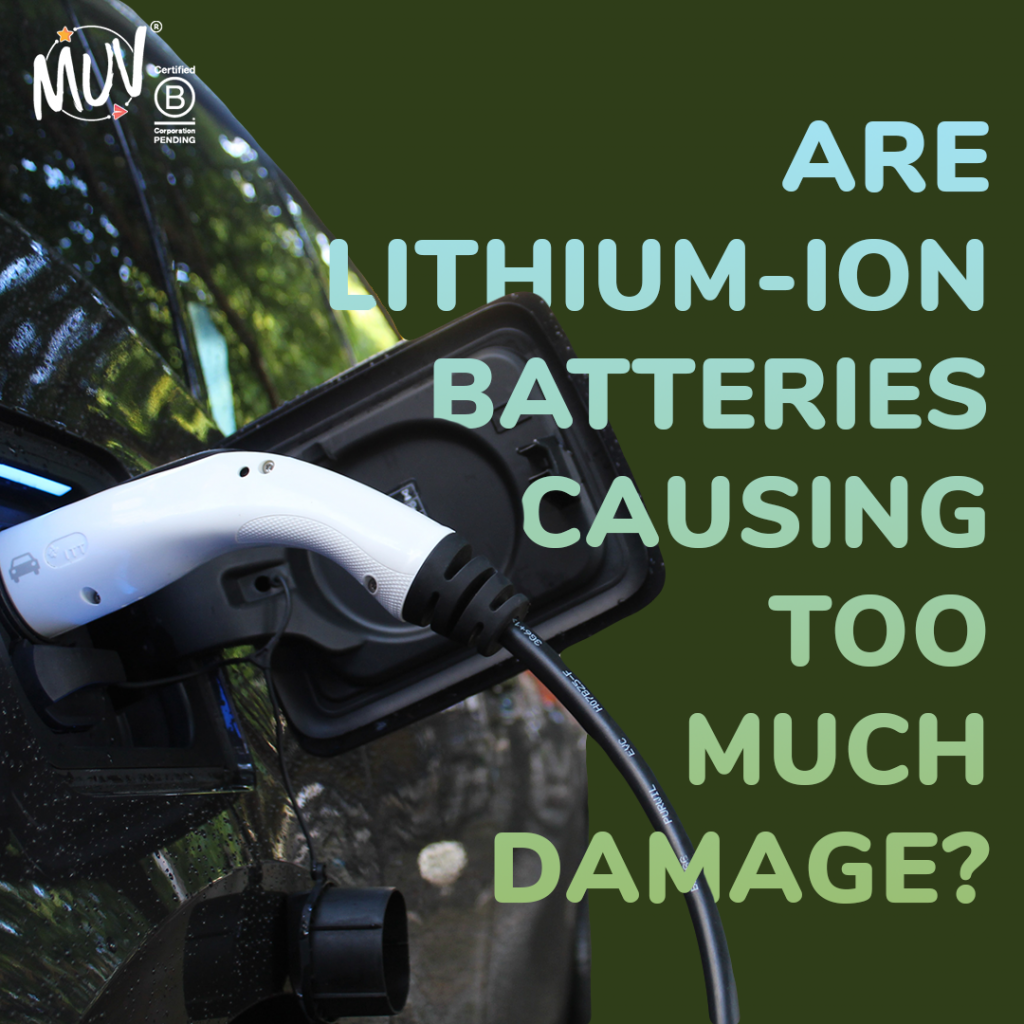5 July 2023
A look at the batteries inside electric cars, bikes, scooters, and motorcycles.
As MUVers know, a huge part of the solution to the climate crisis is improving our transportation sector and ultimately decreasing the number of gas-powered vehicles on the road. For those unable to walk, bike, or take public transit, electric vehicles (EVs) provide a more sustainable mode of transportation than a petrol or diesel vehicle[1], especially when cars can be charged with renewable energy. Across the globe, we’re seeing a rise in the sale and production of electric vehicles. In Europe, EV sales increased by more than 15% last year.[2] In Italy, EV sales decreased last year but have been recovering this year.[3] However, we haven’t perfected the electric vehicle yet. One sustainable issue regarding EVs is their lithium-ion batteries.

Lithium-ion batteries: origins and why they are so important.
Lithium-ion batteries power our phones, iPads and tablets, laptops, electric scooters and bikes, and EVs. A key part of transitioning to renewable energy and electrification is rechargeable batteries, like lithium-ion batteries. Without them, we have no way to store the renewable energy we are creating (which is not available 24 hours a day) and no way to charge portable devices and vehicles.
While lithium-ion batteries have become a necessary part of our daily lives and transition to clean energy, they have serious environmental and social implications. The batteries contain a variety of semi-rare metals, including nickel, manganese, graphite and primarily lithium and cobalt.[4] More than half of the world’s lithium comes from salt flats in Argentina, Chile, and Bolivia.[5] Together, the three countries in South America have been dubbed the “Lithium Triangle.” Seventy percent of the world’s cobalt comes from the Democratic Republic of the Congo (DRC)[6] where China owns the majority of the industrial cobalt mining operations.[7]
Environmental Problems with Lithium-Ion Batteries.
Forty to sixty percent of an electric vehicle’s production emissions come from producing its lithium-ion[8] battery. This contributes to significantly more emissions associated with EV production compared to non-electric vehicles. Lithium-ion batteries have such a high carbon footprint primarily because of the energy involved in chemical and manufacturing processes during production.[9]
Lithium extraction from the salt flats has a variety of negative impacts on the natural environment, including high water usage, disruption of ecosystems with threats to biodiversity, and wetland degradation, as well as global impacts with greenhouse gas emissions from extraction.[10] Cobalt mining has resulted in widespread deforestation, air pollution, and water contamination.[11]
Social Problems with Lithium-Ion Batteries.
Mining in the Lithium Triangle generally involves issues with communication between the mining operations and the local communities[12]. Conditions in artisanal cobalt mines in the DRC include extremely low wages, extremely hazardous working conditions, toxic cobalt fumes, child labor, and child trafficking.[13] Most of the workers have no choice than to accept those conditions in order to make a dollar or two a day to feed themselves, and many of the workers completely lost their villages when industrial mining took over the area.[14] Artisanal mining is illegal but still happens in both artisanal mines and industrial mines.
So, how do we keep moving forward?
How do we continue moving ahead and how can we look forward to this critical part of the clean energy transition?
There are several promising new batteries being researched, developed, and slowly produced across the globe. In the U.S., a tech start-up born out of Stanford University, EnerVenue, is working on a more sustainable metal-hydrogen battery with grid-scale energy storage potential, and at the U.S. Department of Energy’s SLAC National Accelerator Laboratory, researchers are working to develop EV batteries with abundant metals.[15] In Spain, BeePlanet is a company that repurposes lithium-ion batteries after they no longer function in EVs. In a recent exposé about the conditions in DRC’s cobalt mines, Harvard fellow Siddharth Kara supports a focus on reforming the cobalt supply chain to allow continued production of the widely used lithium-ion batteries while transforming the working conditions of cobalt miners.[16]
In addition, as individuals, there are ways we can help to make EV batteries better:
- Support one of the many organizations working to improve conditions in cobalt mines and to stop child labor and improve access to education;
- Encourage lawmakers to support research and development of more sustainable renewable batteries;
- Encourage lawmakers to promote battery reuse and repurposing instead of recycling to increase the lifespan of batteries.
Bibliographic sources
- [1] https://www.sciencedirect.com/science/article/abs/pii/S221478532100763X
- [2] https://www.iea.org/reports/global-ev-outlook-2023/executive-summary
- [3] https://www.rinnovabili.it/mobilita/veicoli-ecologici/aprile-il-mercato-dellauto-elettrica-in-italia-fa-un-balzo-del-299/
- [4] https://www.mckinsey.com/industries/automotive-and-assembly/our-insights/the-race-to-decarbonize-electric-vehicle-batteries
- [5] https://link.springer.com/article/10.1007/s13563-022-00332-4
- [6] https://www.nature.com/articles/d41586-021-01735-z
- [7] https://www.npr.org/sections/goatsandsoda/2023/02/01/1152893248/red-cobalt-congo-drc-mining-siddharth-kara
- [8] https://www.mckinsey.com/industries/automotive-and-assembly/our-insights/the-race-to-decarbonize-electric-vehicle-batteries
- [9] https://www.mckinsey.com/industries/automotive-and-assembly/our-insights/the-race-to-decarbonize-electric-vehicle-batteries
- [10] https://link.springer.com/article/10.1007/s13563-022-00332-4#Sec26
- [11] https://www.npr.org/sections/goatsandsoda/2023/02/01/1152893248/red-cobalt-congo-drc-mining-siddharth-kara
- [12] https://link.springer.com/article/10.1007/s13563-022-00332-4#Sec26
- [13]https://www.npr.org/sections/goatsandsoda/2023/02/01/1152893248/red-cobalt-congo-drc-mining-siddharth-kara
- [14] https://www.npr.org/sections/goatsandsoda/2023/02/01/1152893248/red-cobalt-congo-drc-mining-siddharth-kara
- [15] https://www6.slac.stanford.edu/news/2023-06-22-qa-road-toward-cleaner-batteries
- [16] https://www.npr.org/sections/goatsandsoda/2023/02/01/1152893248/red-cobalt-congo-drc-mining-siddharth-kara












